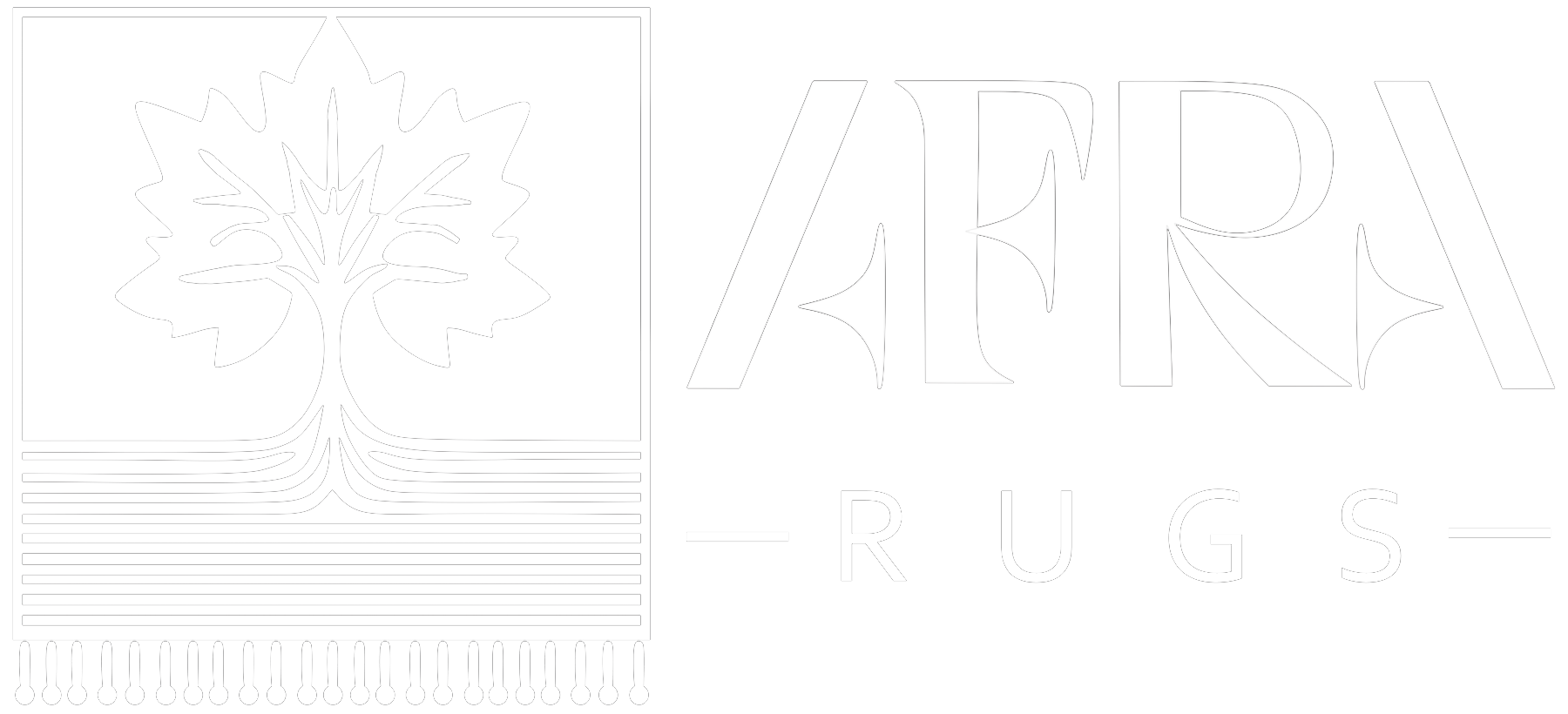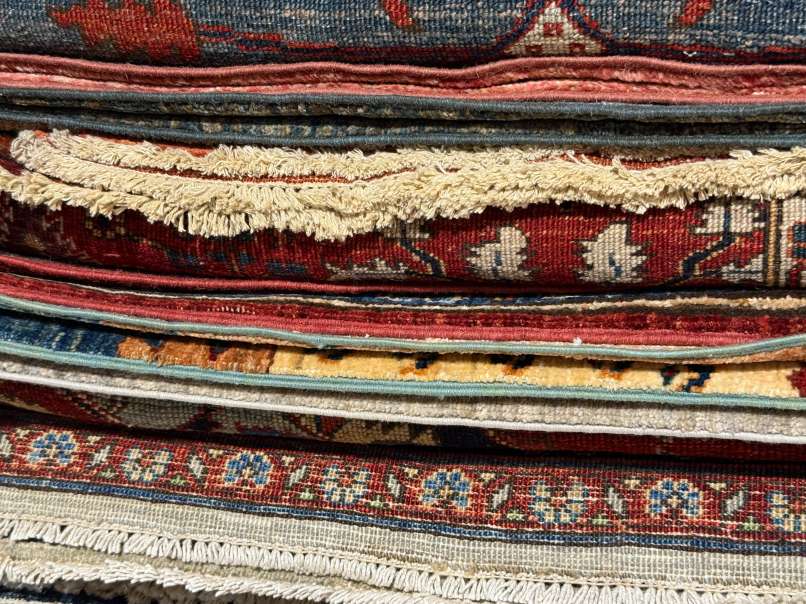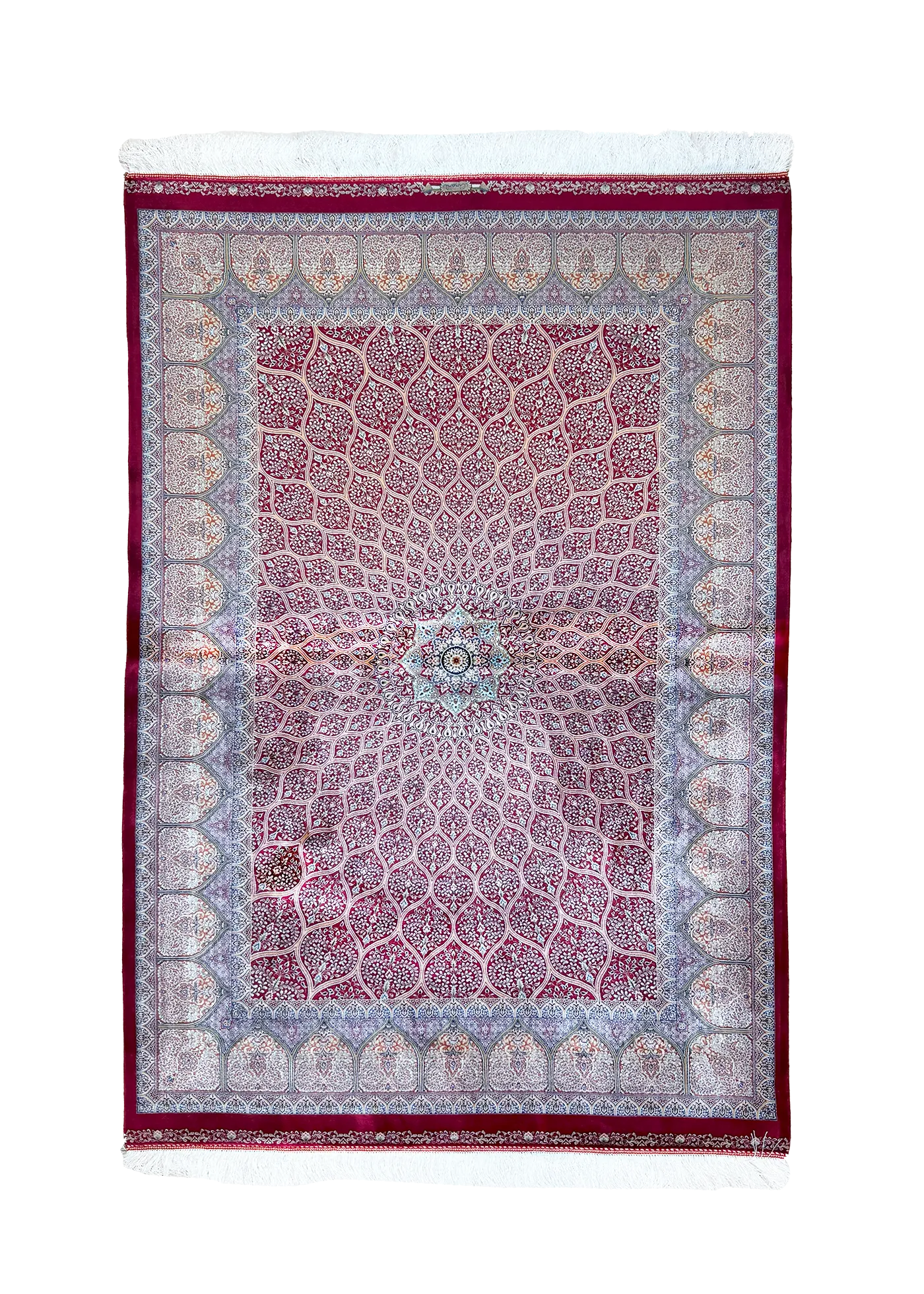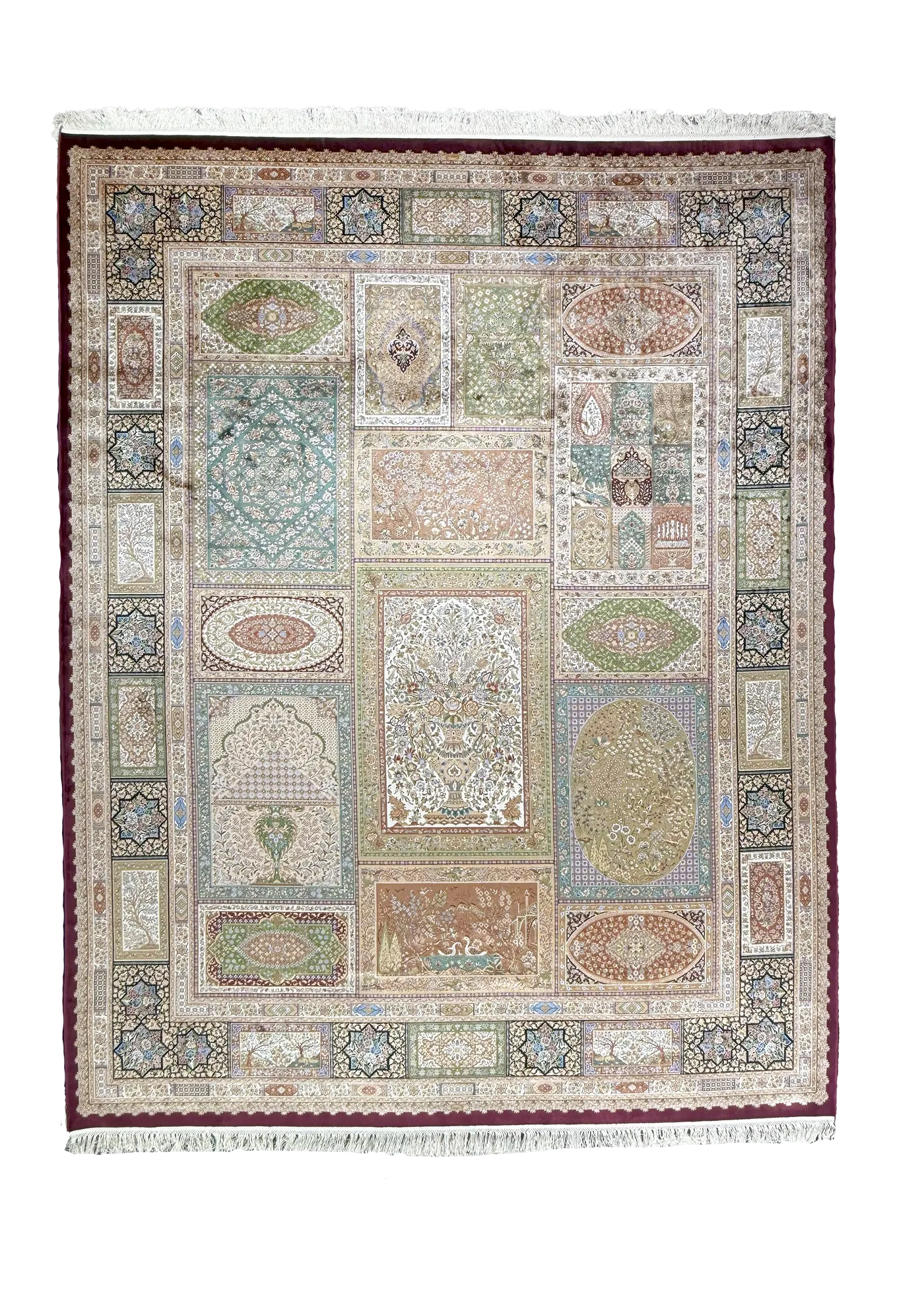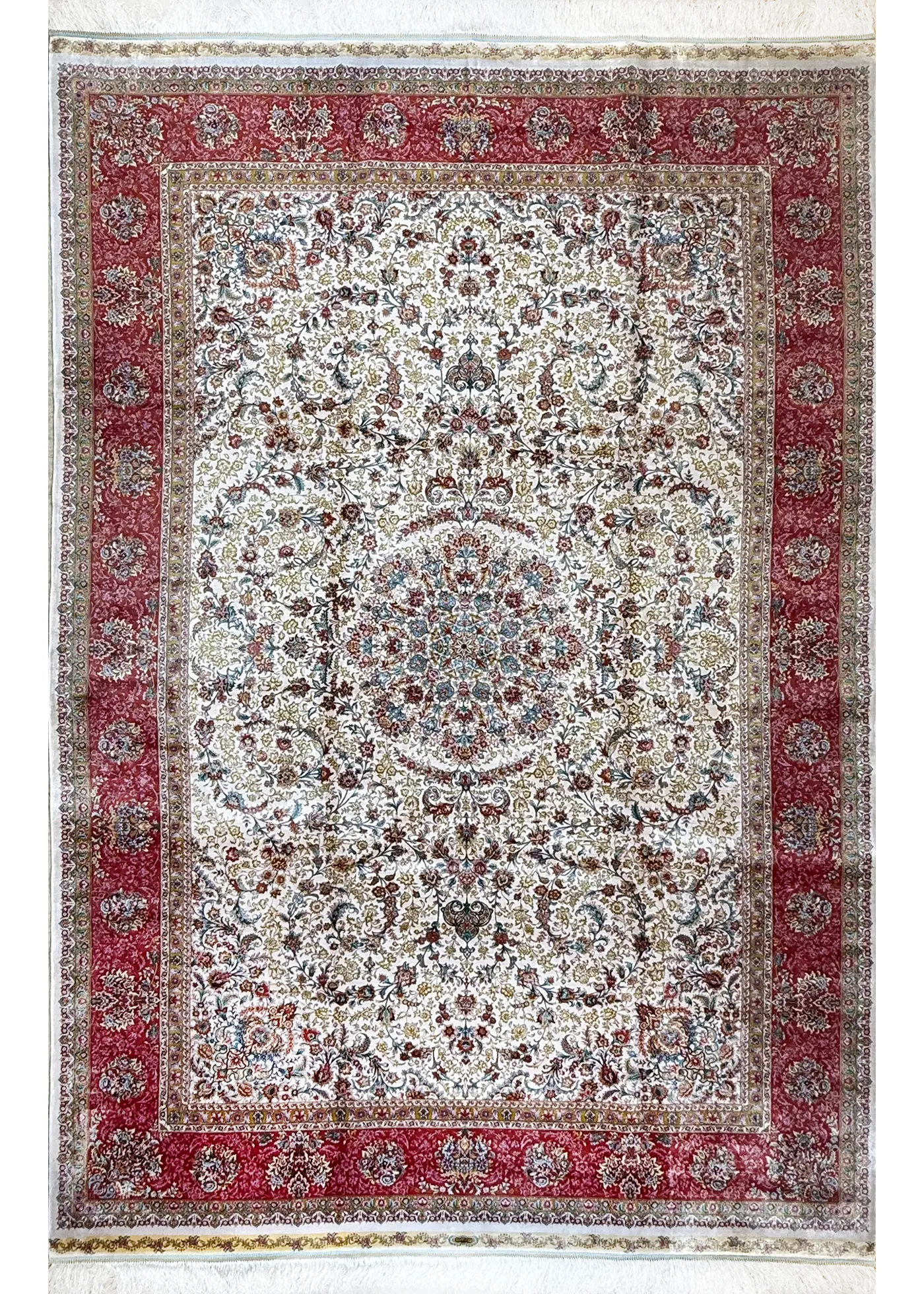The Charm of Miniature Persian Rugs
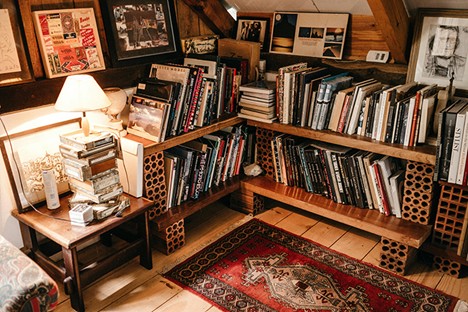
- 1 Red and Blue Persian Rug Vanda Pattern 5 x 8
- 2 Introduction: The Charm of Miniature Persian Rugs
- 3 Section 1: The History and Origins of Miniature Persian Rugs
- 4 Section 2: Craftsmanship and Design in Miniature Persian Rugs
- 5 Section 3: Modern Uses and Appeal of Miniature Persian Rugs
- 6 Section 4: Symbolism and Cultural Significance
- 7 Infographic: Evolution of the Persian Area Rug
- 8 FAQ: Common Questions About Miniature Persian Rugs
- 9 Conclusion: The Charm of Miniature Persian Rugs
Introduction: The Charm of Miniature Persian Rugs
Imagine stepping into a room where a tiny, vibrant Persian area rug catches your eye, its intricate patterns weaving stories of ancient artistry. Miniature Persian rugs, often no larger than a placemat, pack centuries of culture and craftsmanship into their delicate threads. These small treasures captivate collectors, decorators, and anyone drawn to the beauty of Persian design. In this article, we’ll explore the rich history, stunning craftsmanship, modern uses, and cultural significance of the small Persian rug, offering insights to inspire your appreciation for these miniature masterpieces. Whether you’re decorating a cozy nook or seeking a unique accent, you’ll see why these rugs hold timeless appeal. Dive into our 3×5 Medium collection to find a piece that sparks joy in your space.
Section 1: The History and Origins of Miniature Persian Rugs
Miniature Persian rugs trace their roots to the heart of Persian culture, where weavers crafted textiles as both art and utility. Dating back centuries, these small-scale rugs emerged as decorative pieces, often used in ceremonial settings or as gifts. Unlike larger rugs meant for floors, miniature versions served as wall hangings, table covers, or even prayer mats, showcasing the weaver’s skill in a compact form. Their small size made them portable, allowing traders to carry them along ancient routes, spreading Persian artistry far and wide.
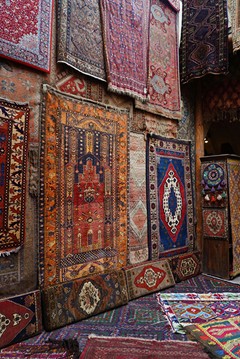
From grand displays like this to the delicate art of the miniature Persian rug, the tradition of weaving continues to captivate. Photo by Zehra Aynacı
These rugs flourished during the Safavid dynasty (1501–1736), a golden era for Persian textiles. Weavers in cities like Tabriz and Isfahan created intricate designs, shrinking grand motifs into tiny formats without losing detail. The Persian area rug, even in miniature, became a symbol of prestige, reflecting the sophistication of Persian courts. While larger rugs adorned palaces, their miniature counterparts decorated private spaces, proving that beauty thrives in any size.
Today, the legacy of these rugs endures, with modern artisans drawing inspiration from historical techniques. A small Persian rug carries the same cultural weight as its larger siblings, making it a perfect blend of history and artistry for today’s homes. As we’ll see, the craftsmanship behind these rugs elevates them beyond mere decor.
Section 2: Craftsmanship and Design in Miniature Persian Rugs
The artistry of a Persian area rug shines brightest in its miniature form, where every knot and color tells a story. These rugs feature intricate patterns, floral medallions, geometric lattices, or swirling arabesques, condensed into a compact canvas. The precision required to create such detailed designs in a small space reflects the weaver’s mastery. Vibrant colors, like deep reds, blues, and golds, bring these patterns to life, making each rug a visual feast.
Weavers often drew inspiration from nature, with motifs like roses, pomegranates, or tree-of-life symbols woven into the fabric. These designs carry cultural weight, reflecting themes of growth, eternity, or protection. For example, a floral medallion might symbolize paradise, while geometric patterns evoke harmony. The small Persian rug maintains these traditional designs, ensuring that even a tiny piece feels like a window into Persian heritage.
Table: Iconic Patterns in a Persian Area Rug
| Pattern | Description | Symbolism |
| Floral Medallion | Central circular motif with floral details | Represents paradise or eternity |
| Herati | Diamond-shaped pattern with fish or leaves | Symbolizes abundance and life |
| Boteh (Paisley) | Teardrop-shaped motif with intricate curves | Evokes fertility or protection |
| Geometric Lattice | Repeating squares or diamonds | Reflects balance and harmony |
This table captures the essence of a Persian area rug, showcasing patterns that define miniature designs. These elements make each rug a conversation starter, whether displayed on a wall or tucked into a small space.
Section 3: Modern Uses and Appeal of Miniature Persian Rugs
A small Persian rug fits seamlessly into today’s homes, offering versatility that larger rugs can’t match. These petite pieces shine in small spaces, think a cozy reading nook, a bathroom corner, or even a dollhouse. Their vibrant colors and intricate patterns add warmth and character, making them ideal for anyone seeking a bold yet compact decor accent. At Afra Rugs, our Bold Hues collection captures this vibrant spirit, perfect for adding a pop of color to any room.
Here are some creative ways to use a small Persian rug in modern interiors:
- Wall Art: Hang a miniature rug as a tapestry to add texture and color to a blank wall.
- Table Accent: Drape a small rug over a side table for an elegant, layered look.
- Dollhouse Decor: Use a tiny rug to furnish a dollhouse, delighting collectors and kids alike.
- Bathroom Charm: Place a small rug by the sink for a touch of luxury in a compact space.
- Shelf Liner: Line a bookshelf with a miniature rug to showcase its patterns.
These uses highlight the small Persian rug’s ability to transform spaces without overwhelming them. Their compact size makes them accessible for renters, small-apartment dwellers, or anyone looking to add Persian flair to a minimalist design. As decor trends lean toward eclectic, meaningful pieces, these rugs remain a timeless choice.
Section 4: Symbolism and Cultural Significance
Miniature Persian rugs do more than decorate, they tell stories through their designs. Each motif carries meaning, rooted in Persian traditions. A boteh (paisley) pattern, for instance, might represent fertility or protection, while a tree-of-life design symbolizes eternal growth. These symbols connect the rug to its cultural origins, making it a piece of art with a narrative.
In Persian culture, rugs often served as storytelling tools, with weavers embedding personal or communal values into their work. A Persian area rug, even in miniature, might reflect a weaver’s hopes for prosperity or peace. These rugs also played roles in ceremonies, from weddings to religious rituals, where their small size made them easy to carry or display.
Today, a small Persian rug brings this cultural depth into modern homes. Whether you place it in a hallway or hang it as art, it carries a legacy of craftsmanship and meaning. By choosing such a piece, you’re not just decorating, you’re preserving a slice of history.
Infographic: Evolution of the Persian Area Rug
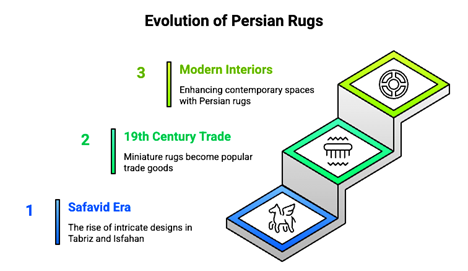
This infographic traces the history of the Persian area rug in miniature form. It begins with the Safavid dynasty (1501–1736), highlighting the rise of intricate designs in Tabriz and Isfahan. It then moves to the 19th century, when miniature rugs became popular as trade goods. The timeline concludes with modern uses, showcasing how these rugs enhance contemporary interiors. Key motifs, like floral medallions and boteh patterns, are illustrated alongside each era. Infographic by Afra Rugs.
FAQ: Common Questions About Miniature Persian Rugs
- What is a miniature Persian rug?
A miniature Persian area rug is a small-scale textile, typically under 3×5 feet, featuring traditional Persian patterns like floral or geometric designs. It’s used for decor, not heavy foot traffic.
- How is a small Persian rug different from a standard one?
A small Persian rug is compact, often used as a wall hanging, table cover, or accent piece, while standard rugs are larger and designed for floors. Both share intricate designs.
- Where can I use a small Persian rug in my home?
Use a small Persian rug as wall art, a table runner, a dollhouse furnishing, or a bathroom accent to add color and texture to small spaces.
- What makes a Persian area rug unique?
A Persian area rug stands out for its intricate patterns, vibrant colors, and cultural symbolism, reflecting centuries of Persian artistry in every design.
- How do I choose the right small Persian rug?
Look for a small Persian rug with colors and patterns that suit your space. Our 3×5 Medium collection offers versatile options for any decor style.
Conclusion: The Charm of Miniature Persian Rugs
Miniature Persian rugs weave history, artistry, and culture into every vibrant thread. From their origins in Persian courts to their modern role as decor accents, these small Persian rugs captivate with their intricate designs and timeless charm. Whether you’re drawn to their floral motifs, geometric patterns, or cultural symbolism, these rugs bring warmth and character to any space. Explore our 3×5 Medium collection to find a Persian area rug that fits your style and transforms your home with a touch of elegance.
